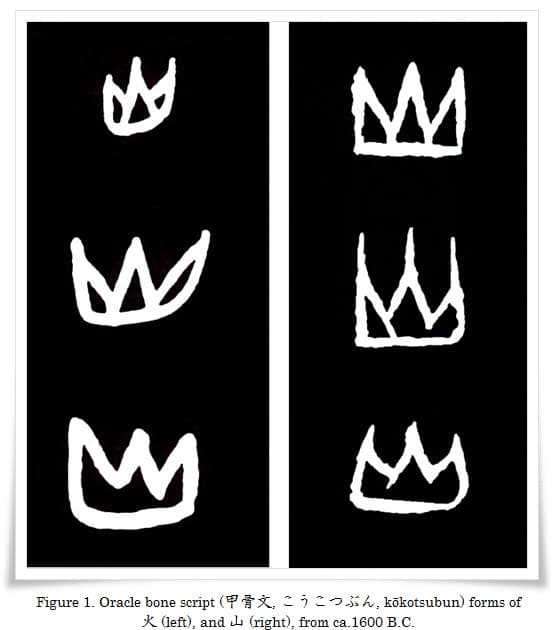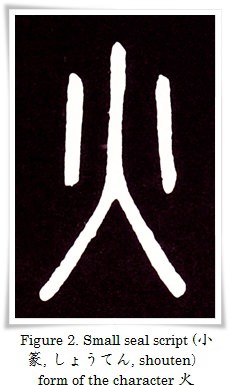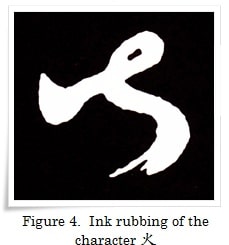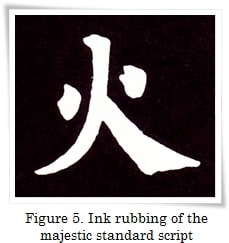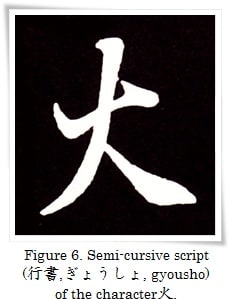1. Meaning:
fire
2. Readings:
- Kunyomi (訓読み): ひ、 -び、 ほ-
- Onyomi (音読み): カ
- Japanese names: does not appear in names
- Chinese reading: huǒ
3. Etymology
火 belongs to the 象形文字(しょうけいもじ, shoukeimoji, i.e. set of characters of pictographic origin). It is a pictograph of blazing flames (Figure 1, left-hand-side column).
The oracle bone script (甲骨文, こうこつぶん, kōkotsubun) forms of the character 火 clearly emphasise its pictographic origin, being an image of fire with three flames. It is important to point out that the oldest forms of 火 can be very similar in shape to the character 山 (やま, yama, i.e. “mountain”), which is a pictograph of three mountain peaks projecting from the base of the mountain range (see Figure 1, right-hand side column).
Later forms of 火 do not change much, becoming slightly more abstract with the evolution of the standard script (楷書, かいしょ, kaisho), Figure 5).
4. Selected historical forms of 火.
Figure 1. Oracle bone script (甲骨文, こうこつぶん, kōkotsubun) forms of 火 (left), and 山 (right), from ca.1600 B.C.
Figure 2. Small seal script (小篆, しょうてん, shōten)form of the character 火, found in the book 說文解字 (shūo wén jiè zì, i.e. “Explaining Simple (Characters) and Analyzing Compound Characters”) from the 2nd century C.E., compiled by a philologist of the Han dynasty (漢朝, 206 BCE – 220 CE), 許慎 (Xǔ Shèn, ca. 58 C.E. – ca. 147 C.E.).
Figure 3. Clerical script form of the character 火, found on the 漢簡 (かんかん, kankan, i.e. “Han dynasty bamboo slips”) that were unearthed in the north-eastern part of the 甘粛省 (Chinese: Gānsù province), early Han dynasty (前漢, 206 – 8 B.C.)
Figure 4. Ink rubbing of the character 火 from the stele 千文字文 (Chinese: qiān wén zì wén, i.e. “one thousand characters text”). Calligraphy in cursive script (草書, そうしょ, sōsho) by 懷素 (Huái Sù, 737–799) of the Tang dynasty (唐朝, 618 – 907).
Figure 5. Ink rubbing of the powerful and proud standard script (楷書, かいしょ, kaisho) from the calligraphy 多寶塔碑 (Chinese: Duō; bǎo tǎ bēi), by 顔真卿 (Yán Zhēnqīng, 709 – 785) of the Tang dynasty (唐朝, 618 – 907), ink rubbing of the stele erected in 752 C.E.
Figure 6. Semi-cursive script (行書, ぎょうしょ, gyōsho) of the character 火. Ink rubbing from the calligraphy by 董其昌 (Dǒng Qíchāng, 1555–1636) of the Ming dynasty (明朝, 1368 – 1644)

